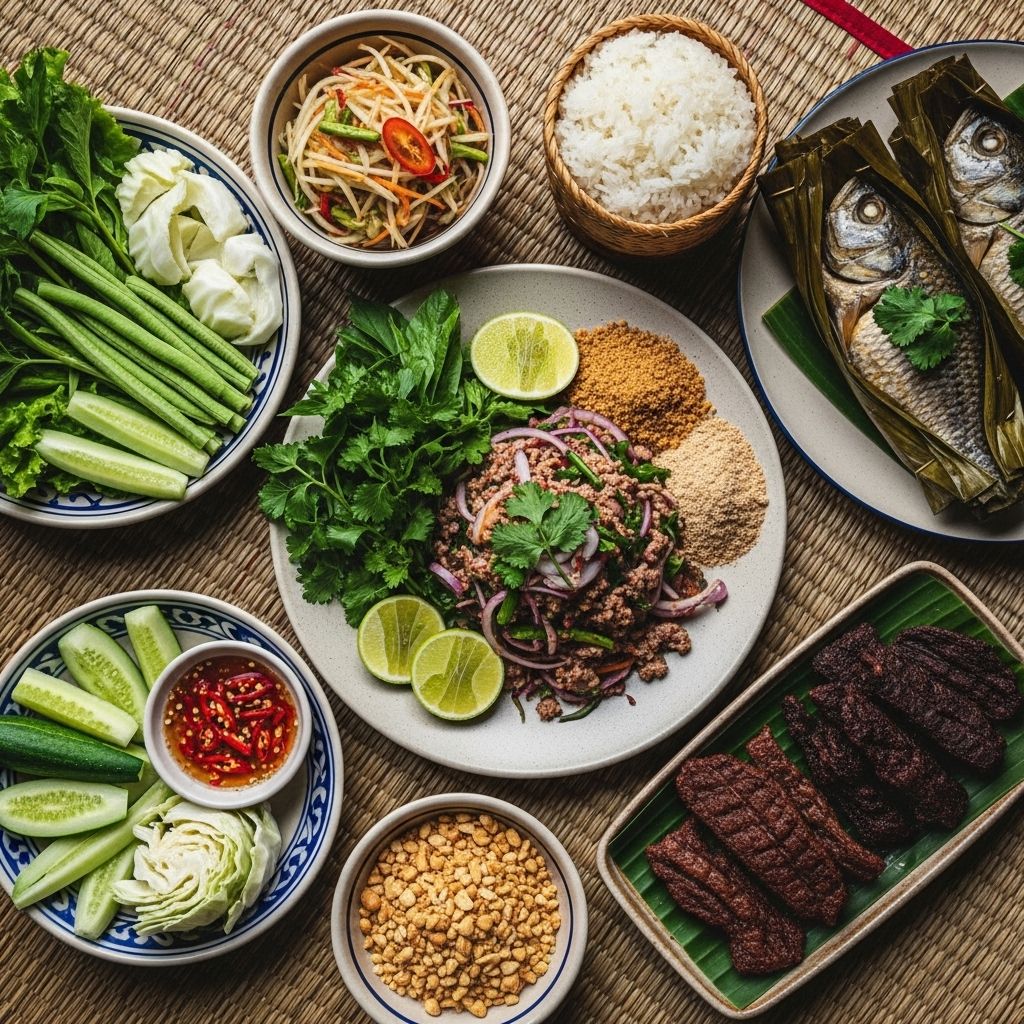Essential Dishes Of Laos: A Complete Guide To Lao Flavors
Bold flavors and shared traditions bring Laos’s dishes to life at every meal.

A Guide to the Essential Dishes of Laos
Lao cuisine is a harmonious blend of bold flavors, fresh herbs, fiery spices, and a deep respect for communal dining. While Laos may be less renowned globally than some neighbors, its food culture is vibrant, complex, and deeply rooted in tradition. From the ubiquitous sticky rice to aromatic salads and deeply savory grilled meats, Lao dishes invite diners to experience the nation’s history and its people’s enduring connection to food and family. This guide explores the most essential dishes of Laos, highlighting what makes them iconic, how they’re enjoyed, and their quintessential place at the Lao table.
The Central Role of Sticky Rice (Khao Niew)
At the heart of Lao cuisine lies khao niew, or sticky rice—a staple that is more than food; it is a cultural anchor. Lao sticky rice is glutinous, steamed in bamboo baskets, and served in lidded sep baskets. Eaten with the hands, this chewy and comforting rice becomes the starting point for almost every meal.
- Sticky rice is traditionally rolled into small balls, then dipped into savory sauces, salads, or paired with grilled meats.
- The importance of sticky rice is such that Lao people are often called ‘luk khao niew’—children of the sticky rice.
The Core Flavors and Building Blocks of Lao Cuisine
Lao food is known for its interplay of herbs, chilies, fermented ingredients like padaek (a thick fermented fish sauce), fresh vegetables, and the pungency of ingredients such as garlic, lemongrass, and galangal. The balance of spicy, sour, bitter, salty, and umami is foundational. Core techniques include pounding ingredients in mortars, grilling over charcoal, and quick, high-heat stir-frying.
- Herbs: Mint, cilantro, dill, and kaffir lime leaves provide freshness and fragrance.
- Fermented sauces: Nam pa (fish sauce), padaek.
- Heat: Chilies, either fresh or dried, are used liberally.
Laab (Larb, Larp): The National Salad
Laab (sometimes written larb or larp) is widely regarded as the national dish of Laos. This salad of minced meat—usually chicken, pork, beef, fish, or even duck—showcases the balance and fresh vibrance of Lao cuisine.
- Preparation: Meat is minced and cooked (or sometimes served raw), mixed with fish sauce, lime juice, ground toasted rice (for crunch), chili, and copious herbs.
- Serving style: Served at room temperature, often with raw vegetables and plenty of sticky rice.
- Variations:
- Laab moo – pork larb;
- Laab gai – chicken larb;
- Laab Seen – beef larb; and more.
- The key is the textural contrast and aromatic intensity from toasted rice powder and fresh herbs.
Tam Mak Hoong (Green Papaya Salad)
Known in neighboring countries as “som tum,” tam mak hoong is Laos’s signature green papaya salad—a dish that’s punchy, spicy, and packed with umami.
- Ingredients: Green (unripe) papaya, cherry tomatoes, snake beans, chiles, garlic, lime, fish sauce, and padaek.
- Preparation: Ingredients are pounded together in a mortar until the flavors meld.
- Distinctive features: Compared to Thai versions, Lao tam mak hoong is typically more savory and aromatic, thanks to extra padaek and chili.
Khao Piak Sen (Lao Noodle Soup)
Khao piak sen is a beloved Lao noodle soup reminiscent of chicken noodle soup but with a distinctly local twist.
- Soup base: Rich chicken broth, seasoned with fish sauce, garlic, and ginger.
- Noodles: Fresh, chewy, hand-pulled rice noodles give the dish much of its comforting texture.
- Garnishes: Often topped with fried garlic, chopped cilantro, scallions, lime wedges, and sometimes shredded chicken or pork.
- Serving occasion: Eaten for breakfast, lunch, or any time comfort is required.
Khao Poon (Red Curry Noodle Soup)
Khao poon is another noodle-based street food favorite, featuring a spicy, aromatic red curry broth.
- Key components: Thin fermented rice vermicelli noodles bathed in coconut milk-infused curry with ground pork, chicken, or fish.
- Common vegetables: Cabbage, bamboo shoots, and banana blossom.
- Signature toppings: Shredded herbs, fresh bean sprouts, lime, and generous chili flakes.
Sai Oua (Lao Sausage)
Sai oua is a famous Lao sausage, perfumed with aromatic lemongrass, kaffir lime leaves, galangal, and sticky rice. Similar sausages exist in Thailand’s Lanna region, but Lao versions are uniquely seasoned and often served with sticky rice and a fiery chili dip (nam jeo).
- Main ingredients: Minced pork, aromatic herbs, fresh chiles.
- Flavor profile: Savory, citrusy, spicy, and herbal, with a satisfying fat content that crisps up when grilled.
Nam Khao (Crispy Rice Salad)
Nam khao or “crispy rice salad” is a centerpiece of Lao party tables and family gatherings.
- Preparation: Cooked rice is mixed with red curry paste, coconut, and egg, then formed into balls and deep-fried until golden.
- Serving: The crispy rice balls are crumbled and tossed in a salad with sour pork sausage, fresh herbs, peanuts, and a tangy fish sauce and lime dressing.
- Eating style: Served with lettuce leaves for wrapping, providing a crunchy, fresh contrast.
Sien Savanh (Lao Beef Jerky)
Sien savanh is the Lao take on beef jerky. Thin strips of beef (or sometimes pork) are marinated in a blend of soy sauce, garlic, oyster sauce, black pepper, and palm sugar, then sun-dried and briefly grilled for a smoky finish.
- Flavor and texture: Chewy, salty, savory—with occasional notes of sesame and chili.
- Commonly served with: Sticky rice and a spicy tomato-based dip known as jaew mak len.
- Occasion: Popular as a snack on the go, found at bus stops, markets, and roadside stalls.
Jaew: Spicy Lao Dips
Jaew refers broadly to the family of spicy Lao dipping sauces, each bringing complex flavor to the meal.
- Jaew bong: A sweet, smoky relish made with dried chilies, galangal, garlic, and sometimes buffalo skin.
- Jaew mak len: Spicy tomato dip, grilled or roasted and pounded with chili, garlic, and herbs.
- Jaew som: A sour chili dip based on pickled chilies.
- Typically enjoyed with sticky rice, grilled meats, and fresh raw vegetables.
Ping (Grilled Dishes)
Grilling over charcoal, or ping, is integral to Lao street and home cooking.
- Ping gai: Grilled chicken, marinated with lemongrass, garlic, fish sauce, and turmeric.
- Ping sin: Grilled beef or pork.
- Grilled fish, such as ping pa, often stuffed with herbs and cooked whole.
- Served with sticky rice, jaew, and heaps of fresh herbs, ping dishes are a cornerstone of festive eating.
Other Lao Culinary Highlights
- Khao Jee (Lao Baguette): Legacy of the French colonial period; a crusty baguette filled with pate, grilled meats, pickles, and herbs. The Lao sandwich, reminiscent of Vietnamese banh mi, is a beloved breakfast or snack.
- Fermented fish and meats: Padaek, a thick, chunky fermented fish sauce, is a backbone ingredient in many salads and dips.
- Snack culture: Insects, fried river weeds, and savory pancakes made from rice flour and scallions appear at markets and on street stalls.
The Importance of Communal Dining and Eating Etiquette
Lao meals are social events. Dishes are served family-style, with everyone sharing from central plates. Sticky rice is communal, passed and replenished at will. Eating with the hands, particularly the right hand, is standard, with rice forming a scoop for savoring salads, dips, and grilled items.
- Respect tradition: Always receive and offer food with the right hand or both hands as a sign of respect.
- Drink pairing: Lao lao (rice whiskey) is the customary drink, often enjoyed at gatherings or while feasting.
What Makes Lao Cuisine Unique?
- Lao food is less sweet than Thai cuisine, favoring bitter, sour, and earthy flavors.
- The use of padaek adds a distinctive deep umami found nowhere else.
- Sticky rice as the main carbohydrate shapes not only the meals but also the techniques and etiquette.
Frequently Asked Questions (FAQs)
Q: What is the most important ingredient in Lao food?
A: Sticky rice is the fundamental staple and is served at nearly every meal, shaping both flavor and dining tradition.
Q: Is Lao food very spicy?
A: While Lao food can be quite spicy, especially with salads and dips, heat levels can often be adjusted. Dishes balance heat with fresh herbs and citrus.
Q: What proteins are commonly used in Lao cuisine?
A: Pork, chicken, fish, and beef are primary, with occasional inclusion of duck, river fish, water buffalo, and even insects in rural areas.
Q: How is Lao food typically eaten?
A: Traditionally, with the hands—particularly using sticky rice to scoop up sides and salads. Meals are shared communally.
Q: Are there vegetarian options in Lao cuisine?
A: While meat and fish are central, many vegetable-based salads, grilled vegetables, and some noodle dishes can be found, especially in markets.
Conclusion
Lao cuisine is a tapestry woven from tradition, geography, and a deep reverence for local ingredients. Whether you’re sampling laab, savoring the fiery dips of jaew, or simply enjoying sticky rice baked in bamboo, each dish offers a taste of Laos’s vibrant cultural mosaic. From bustling markets to family tables, these essential dishes invite you to discover the heart and soul of Laos—one bite at a time.
References
Read full bio of Srija Burman












